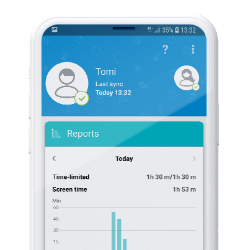How are my kids interacting with social media daily?
Trends are great until we fall for them.
The most downloaded app of 2021, TikTok, has been gaining popularity amongst people under 25 for a long time. It´s entertaining, and it gives people an opportunity to express their creativity as well as to share with friends and strangers their thoughts, news and skills. But under that shiny outer shell, a few risks are brewing.
TikTok came to the scene in 2016 and was booming during the pandemic. And rightfully so – kids were stuck at home with virtually no way to connect to their friends besides social media. TikTok challenges, dances and lip-synch battles were all things that kept on growing the app, as well as the app´s popularity.
You may have noticed that there has been some fuss around TikTok lately. It started with state workers being banned from using the app and is finding its way into family life. The uncertainty about the app´s security, safety and privacy for children is one of the reasons TikTok CEO Shou Zi Chew is to address the question of protecting children on the app before the U.S. Congress on March 23.
The concerns include the app’s algorithm favouring certain types of content and feeding them to children. These might consist of sexually suggestive content, videos depicting eating disorders and other harmful types of content. The issue is present on almost all social media platforms; however, no other platform comes close to the popularity of TikTok among youngsters.
Apart from that, TikTok has been facing allegations of massive data harvesting. In essence, this means that the app demands more permissions than it needs as an entertainment app.
Earlier this month, TikTok announced new features to help parents feel more secure about the app. The first tool allows parents to prevent their children from viewing certain types of content based on certain words or hashtags.
Another feature aims to limit the amount of time users spend on the app, plus it would automatically block users under the age of 18 from using the app for longer than an hour a day.
TikTok is also trying to protect young children by setting their accounts to “private” by default, in contrast to users over the age of 15, whose profiles are all “public.” Also, content created by children under the age of 16 is restricted from being downloaded unless manually changed in the settings. The official minimum age of TikTok users is 13, but no age verification mechanism exists.
One of the features TikTok offers is “Family Pairing,” which allows you to link your child´s profile to yours, meaning you can control direct messages, set screen time limits and turn on/off restricted content directly. You will also receive a notification if any settings are changed or turned off on your child´s phone.
It is a useful tool that the app offers for parents to have some control over the content their children consume and the people they might interact with online. The feature is TikTok´s version of parental control.
TikTok can be a very positive place for a child. It can support your child´s creativity and help build their social network. It is an excellent tool for them to express themselves and communicate with friends. Making sure you consider the positives before banning something creates more trust and allows your children to enjoy the progress of technology safely. Be the voice to guide them through the jungle of the digital world and create a safer space for them online.
Parents and guardians must limit screen time and keep their kids safe online with the school holidays almost here. Get tips on reducing screen time during the holidays with Safer Kids Online!


With ESET Parental Control for Android
TRY FREE FOR 30 DAYSTrends are great until we fall for them.
In our present digital age, where social media platforms are a hub for connection, it's crucial to understand the implications of oversharing, particularly for our kids.
By sharing more we can prevent oversharing